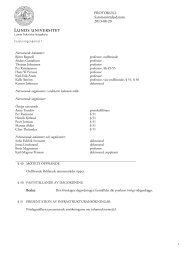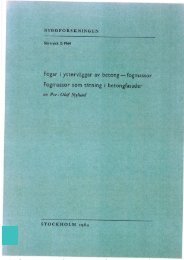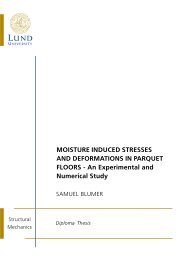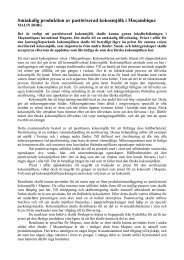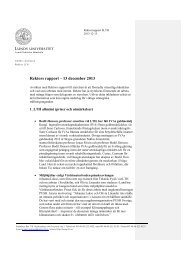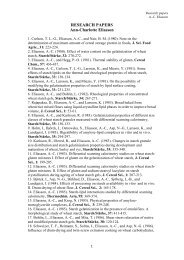Solvärme genom fönster och solskydd - Lunds Tekniska Högskola
Solvärme genom fönster och solskydd - Lunds Tekniska Högskola
Solvärme genom fönster och solskydd - Lunds Tekniska Högskola
Create successful ePaper yourself
Turn your PDF publications into a flip-book with our unique Google optimized e-Paper software.
SUMMARY<br />
UDC 69.028.3<br />
BROWN, G.-ISFÄLT, E.: Solar<br />
Shading Devices. VVS 36 (1965)<br />
No. 6- P. 315-324.<br />
The purpose of a solar shading device<br />
on a window is to reduce the<br />
heat gain caused by radiation f¡om<br />
sun and sky. It should at the same<br />
time diffuse the sunlight as evenly as<br />
possible throughout the room and<br />
prevent glare by screening off the<br />
¡adiation that would otherwise fall<br />
direct on lighrcoloured surfaces within<br />
the field of vision of the occupants<br />
of the room. The view from the window<br />
should be obstructed as little as<br />
possible. In some cases the chief<br />
purpose of the shading device is to<br />
combat the delete¡ious effect of sunlight<br />
on fabrics, paintwork etc.<br />
The maximum heat gain through<br />
a double-glazed window with plain<br />
plate-glass panes f¡om solar and<br />
sky radiation is about 600 kcalihr per<br />
sq.m of glass. At the latitude of<br />
Stockholm, the rnaximum heat gain<br />
is reached as carly as March in a<br />
window facing due south, but not<br />
until June in eastern and western<br />
windows.<br />
To avoid discomfort due to solar<br />
radiation, windows in workplaces<br />
sohuld preferably be on a shaded<br />
side. A westerly aspect is better than<br />
an easterly one, as a westward-facing<br />
room does not heat up until the<br />
evening, after working hours, and<br />
cools down again overnight.<br />
Of the radiation falling upon a<br />
single pane of gÌass, part is reflected,<br />
a further part is absorbed by the<br />
glass, and the remainder is transmitted<br />
direct, i.e. it passes through<br />
the surface of the glass on the inside<br />
of the room. The absorbed energy is<br />
converted into heat and is given off<br />
partly to the room and partly to the<br />
exterior envi¡onment in inverse proportion<br />
to the surface thermal resistances.<br />
The total heat again due to<br />
radiation is made up of the directly<br />
transmitted component and that part<br />
of the abso¡bed energy which is reemitted<br />
to the room.<br />
It is possible by adding iron oxide<br />
to the glass to increase the absorption<br />
of the invisible, infrared part of solar<br />
radiation more than that of the visible<br />
spectrum (heat-absorbing glass).<br />
This reduces the direct transmission.<br />
Another way of obtaining the same<br />
result which is still being studied is<br />
to vary the reflection of radiation<br />
in differenr wavelength ranges by<br />
coating the surfaces of the glass (selective-¡eflection<br />
glass). IJp to now<br />
metallic coatings have mainly been<br />
used on insulating glass, the coating<br />
being applied to the inside of the<br />
outer pane. Since insulating windows<br />
are he¡metically sealed, the coating<br />
is well protected against both mechanical<br />
and chemical damage.<br />
If one of the panes in a doubleglazed<br />
window is of the heat-absorbing<br />
type, this pane should be placed<br />
outermost, in acco¡dance with the<br />
rule that the trapped heat shall as far<br />
as possible be given off to the exte¡ior<br />
and not to the ¡oom. This rule<br />
should be followed for the location<br />
of all types of solar shading devices.<br />
A venetian blind, for example, is<br />
most effective if it is placed outside<br />
the window, so that the heat absorbed<br />
by the slats is given up to the outside<br />
air. If the blind is placed between the<br />
panes of a duoble-glazed window,<br />
heat is given off both to the ¡oom and<br />
to the exterior. With the blind on<br />
the inside, nearly all the absorbed<br />
heat is ¡e-emitted to the room.<br />
A solar shading device inside a<br />
rvindow should have a highly reflective<br />
surface. The glass should absorb<br />
as little heat as possible, so that reflccted<br />
radiation can easily pass out<br />
through it again. In this case it is<br />
entirely wrong to use heat-absorbing<br />
glass.<br />
Thc effectiveness of a shading device<br />
placed between two panes can<br />
be increased by ventilation of the<br />
layer of air in which the device is<br />
located. This ventilation is particularly<br />
effective with appliances which<br />
absorb a great deal of solar heat,<br />
snch as venetian blinds.<br />
It is of course desirable to make<br />
the lower part of a shading curtain<br />
transparent enough to permit objects<br />
outside the window to be distinguished.<br />
If the upper part of the curtain<br />
is more closely woven, to reduce the<br />
transmission through it as far as possible,<br />
this inc¡eases the shading effect<br />
without causing inconvenience.<br />
Table I shows the amount of radiation<br />
passing through various window<br />
combinations as compared to the radiation<br />
through a double-glazed window<br />
with panes of ordinary plate<br />
glass. The shading coefficients F1, Fp<br />
give this relationship with reference<br />
to total heat gain and direct-transmitted<br />
radiation respectively. The last<br />
column of the table contains the heat<br />
trarumission coefficients for the different<br />
combinations to permit calculation<br />
of the heat transmitted<br />
through the window due to the difference<br />
between outside and inside<br />
air temperature in addition to the<br />
transmission of radiant heat.<br />
The figures in the table refer to<br />
single, double and triple-glazed windows,<br />
without shading devices, or<br />
with curtains, or with venetian blinds;<br />
in some cases one pane is heatabsorbing<br />
or metal-coated.<br />
To calculate the heat gain from<br />
solar and sky radiation through<br />
a lv,indow combination listed in<br />
the table, one multiplies the heat<br />
gain (per sq.m of glass area) through<br />
an unshaded double-glazed window<br />
with ordinary plate-glass panes by the<br />
shading coefficient given in the table.<br />
The heat gain for a window with ah<br />
awning in a sunlit facade can be read<br />
off direct from fig. B if the altitude<br />
of the sun and the albedo of the<br />
ground outside the window are<br />
known. Figures for albedo are given<br />
in table 2.<br />
It is hoped to publish later some<br />
further results from a series of measurements<br />
now being made at the<br />
Royal Institute of Technology in<br />
Stockholm of the shading coefficients<br />
of various types of solar shading devices,<br />
together with graphs showing<br />
the sola¡ heat gain through doubleglazed<br />
windows with plate-glass<br />
panes.<br />
L¡ttêrotur<br />
l. Alderson, /. I1..' Sun control -<br />
a new development.<br />
Journal of the IHVE, dec. 1960.<br />
2. Farber, E. A., Smith, W. A., Pennington, C. W. <strong>och</strong><br />
Reed, l. C.: Theo¡etical analysis of solar heat gain<br />
through insulating glass with inside shading. AS,HRAE<br />
Journal, aug. 1963.<br />
3. Pennington, C. W., S¡nith, W. A., Farber, E. A. <strong>och</strong><br />
Reed, J. C..' Experimental analysis of solar heat gain<br />
through insulating glass with inside shading. ÄSHRAE<br />
Journal, febr. 1964.<br />
4. Parmalee, G, V. <strong>och</strong> A,ubele, W, W.r The shading of<br />
sunlit glass. An analysis of the effect of uniformly spaced<br />
flat opaque slats. ASHRAE Trans. 1952, p. 377.<br />
5<br />
Ozisik, N. <strong>och</strong> Schutrum, L. F,: Solar heat gains through<br />
slat-type between-glass shading devices. ASH,RAE T¡ans.<br />
1960, p. 359.<br />
6. ASHRAE Guide and Data Book .1963. Fundamentals<br />
& Equipment (Chapter 26: Air Conditioning Cooling<br />
Load).<br />
7. Ozisik, N. <strong>och</strong> Schutrum,.L. F..' Heat gain through<br />
windows shaded by canvas awnings. ASRAE Trans. 1958,<br />
p. 463.<br />
B. Ozísik, N. <strong>och</strong> Schutrurn, L. F.: ,Heat gain through<br />
windows shaded by metal awnings. ASHRAE Trans.<br />
1959, p.311.<br />
27




